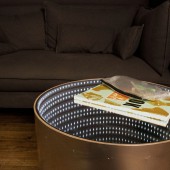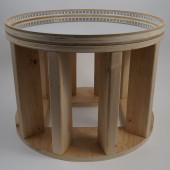Infinitum Infinity Mirror Table by Louise-Anne van 't Riet |
Home > Winners > #39121 |
 |
|
||||
| DESIGN DETAILS | |||||
| DESIGN NAME: Infinitum PRIMARY FUNCTION: Infinity Mirror Table INSPIRATION: I was inspired by untidy people. I decided to design a table that will light up when objects are placed on it, giving users a beautiful backdrop for their objects and the illusion of an infinity hole in the floor, but also force them to clean everything up before they leave the room, because the light will only go off once there is nothing left on the table. UNIQUE PROPERTIES / PROJECT DESCRIPTION: I wanted to design a table that would light up when objects were placed on it, giving people a beautiful backdrop for their objects and the illusion of an infinitely deep hole in the floor. Infinitum is an arduino-powered table that turns on when items are placed on it, and which turns off when they are removed. This infinity mirror table is designed for people who never tidy up, but leave their belongings everywhere. I decided to design a table that would light up when objects were placed on it, giving people a beautiful backdrop for their objects and the illusion of an infinitely deep hole in the floor. This would also encourage users to tidy up before they left a room because the light would only switch off once there was nothing left on the table. The table is a set of plexiglass mirrors, set up so that the LEDs between them reflect an image back onto the fully reflective mirror. The table construction includes a piezo sensor switch which, when activated, will light the table up. OPERATION / FLOW / INTERACTION: The table construction includes a piezo sensor switch which, when activated, will light the table up. The piezo sensor converts vibration to voltage or voltage to vibration. That means people can use this as a buzzer for making beeps, tones and alerts AND use it as a sensor, to detect fast movements like knocks. In simple terms, the vibration of an object being set on the table will trigger the piezo sensor, a switch capable of detecting fast movements. Once the piezo is set off, the NeoPixel Digital RGB LED strip turns on white lights. The piezo, as well as the LEDs, are both connected to an Arduino board hidden in the table that is accessible through a hole that is under the table. PROJECT DURATION AND LOCATION: This project lasted 5 weeks from concept to finishing touches and was created in New York City. FITS BEST INTO CATEGORY: Furniture Design |
PRODUCTION / REALIZATION TECHNOLOGY: The table is a set of plexiglass mirrors, set up so that the LEDs between them reflect an image back onto the fully reflective mirror. The table construction includes a piezo sensor switch which, when activated, will light the table up. To create the tabletop, Lou created a double-lipped ring. She used the CNC router to cut one 22-3/8” diameter ring and two 22” diameter rings with 22-3/8” lips. She then glued the rings together with wood glue and clamps. The lips allow the plexiglass mirrors to sit apart from each other and to create for the LED strip. The base of the table is made up of two 22-3/8” diameter wood circles and eight 2”x4”x13-3/4” PLY wood slats. The slats are sandwiched between the two wood circles, creating a solid structure to support the tabletop. On top of this, a one-way plexiglass mirror will reflect the LEDs into a two-sided plexiglass mirror, creating a series of smaller and smaller reflections that appear to recede into an infinite distance. SPECIFICATIONS / TECHNICAL PROPERTIES: Materials Needed: One-way plexiglass mirror (diameter: 22”), Two-sided plexiglass mirror (diameter: 22”), PLY wood & MDF wood (diameter: 22-3/8”), Metal Sheet (2 sheets of 24”x36”), Screws (#16 x 1-1/4”), Wood glue, Arduino board. TAGS: Infinity, Mirror, Table, Arduino, Lights, Design, Furniture, LEDs, Plexiglass, CNC RESEARCH ABSTRACT: Tools Needed: CNC Router, Machine, Miter Saw, Sandpaper (120 grits), Soldering iron & solder, Helping Clamps, Cordless Power Drill. CHALLENGE: The hardest part of this project was the coding. ADDED DATE: 2015-02-19 03:12:46 TEAM MEMBERS (1) : IMAGE CREDITS: Louise-Anne van 't Riet, 2014. |
||||
| Visit the following page to learn more: http://www.louvtr.com | |||||
| AWARD DETAILS | |
 |
Infinitum Infinity Mirror Table by Louise-Anne Van 't Riet is Winner in Furniture Design Category, 2014 - 2015.· Read the interview with designer Louise-Anne van 't Riet for design Infinitum here.· Press Members: Login or Register to request an exclusive interview with Louise-Anne van 't Riet. · Click here to register inorder to view the profile and other works by Louise-Anne van 't Riet. |
| SOCIAL |
| + Add to Likes / Favorites | Send to My Email | Comment | Testimonials | View Press-Release | Press Kit |
Did you like Louise-Anne Van 't Riet's Furniture Design?
You will most likely enjoy other award winning furniture design as well.
Click here to view more Award Winning Furniture Design.








